Generally speaking, it is rather difficult to distinguish the difference between Shibazakura and Phlox subulata without professional knowledge. Because they both have small and lovely flowers after blooming, and they can both produce mostly pink or white flowers, and the visual effect is very eye-catching, so it is easy to get them confused.
The Difference between Shibazakura and Phlox subulata
The appearances of Shibazakura and Phlox subulata are similar. That's because they belong to the same kind of plant, and the only difference is the different names in different places. In relevant flower books, the scientific name of these two plants is Phlox paniculata. In China, they are usually uniformly called Phlox subulata, which is a perennial herbaceous plant. The flowering period is mostly from March to May in spring. However, in suitable climates, they can also bloom from July to September. The petal colors include white, pink, purple or red.
Whether Phlox subulata is Cold-resistant
In the southern flower market, Phlox subulata is not common, but it can be seen in the northern flower market. It can be regarded as an extremely cold-resistant plant. As long as the low temperature in winter does not exceed -32 degrees Celsius, it can survive smoothly. Its suitable temperature is around 15 - 26 degrees Celsius. However, even at -8 degrees Celsius, you can still see its evergreen leaves growing on the plant. It can be seen that it is a cold-resistant plant with extremely strong vitality.
Growth Environment
Phlox subulata is not strict with soil requirements. However, if you want it to grow more vigorously, you can provide it with well-drained and loose loam soil. At the same time, you can usually give it sufficient sunlight. You don't need to worry that high temperature will hinder its growth because it can endure both severe cold and high temperature. In terms of watering, just follow the principle of "watering when the soil is almost dry".
Value
In ancient times, Du Fu described Phlox subulata in his poem. He wrote, "In front of Lady Huang's house, flowers crowd along the path, thousands of them weigh down the branches. Lingering butterflies dance from time to time, and charming orioles sing merrily." This exactly shows that in daily use, it can be planted in large areas on flat ground, slopes or hanging on walls. At the same time, it can also replace traditional lawns and be used as ground cover in courtyards.
Are Phlox and Shibazakura the same kind of flower?

Share with
Tagged in :




Leave a Reply